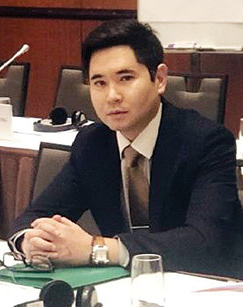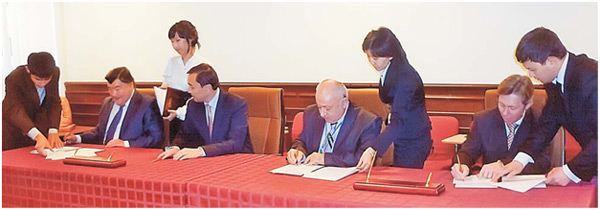Questionnaire of JINR Weekly Newspaper
Interview, 15 January 2021
Today, the JINR Weekly Newspaper opens the jubilee project dedicated to the 65th anniversary of the Institute: staff members from the JINR Member States whose lives are closely related to the Institute will answer the questions of the Newspaper. Head of the national group of Kazakhstan in JINR Damir Aznabayev opens the series of articles.
 1. How did you first learn about JINR? What role has Dubna played in your scientific career?
1. How did you first learn about JINR? What role has Dubna played in your scientific career?
My first acquaintance with JINR took place in the Al-Farabi Kazakh National University when courses were organized with the participation of Professor of this University Minal Dineikhan. Professors from JINR came to our University and provided lectures, solved tasks jointly with us. Moreover, we were told about JINR. I am very grateful to Academician Kairat Kamalovich Kadyrzhanov and my scientific supervisor Professor Minal Dineikhan for their support and opportunity to come to JINR for work.
2. Which of the “founding fathers” of the Institute the Dubna streets are named after is of special importance to you?
Of course, the streets named after great scientists are important to all of us. They fill the city where we live and work with a special flavour. Such names as D. I. Blokhintsev, N. N. Bogoliubov, V. I. Veksler, M. G. Meshcheryakov, V. P. Dzhelepov, I. M. Frank, G. N. Flerov, A. M. Baldin remind us of the considerable contribution to the creation and development of the Institute the “founding fathers” made. They laid the foundation of our international scientific centre.
3. With what Dubna scientists do you keep in close contact?
Nowadays, representatives of the Republic of Kazakhstan work at all the JINR laboratories. They write theses, take part in experiments. As head of the national group of the Republic of Kazakhstan, I support contacts with numerous scientists from various laboratories. I work at the Bogoliubov Laboratory of Theoretical Physics, in the scientific Department of Fundamental Interaction Theory headed by a leading researcher V. I. Korobov.
4. What are the brightest examples of the cooperation of scientific centres, physicists of your country with JINR in your opinion?
One of the brightest examples of cooperation is the double degree programme implemented in the framework of the agreement signed in Nur-Sultan. This agreement includes joint training of the personnel on nuclear physics between the Institute of Nuclear Physics of the Republic of Kazakhstan, the Eurasian National University, the Al-Farabi Kazakh National University, the State University “Dubna”, and the Joint Institute for Nuclear Research. The training programme is now a significant component of our partnership. Thanks to this programme every year, students from the Republic of Kazakhstan have an opportunity to study in Dubna while masters and doctoral students can take an internship. The number of young employees from Kazakhstan is growing from year to year. Nowadays, in the frames of the agreement, more than 100 Kazakh bachelor and master students have been trained in Dubna State University and the Joint Institute for Nuclear Research. More than 30 employees are postgraduates or PhD students of higher education institutions of the Republic of Kazakhstan and the Russian Federation. Kazakh specialists have defended 10 PhD and (or) candidate dissertations at JINR and domestic universities from 2010 to 2020.
 Astana (Kazakhstan), 19 November 2009. Signing of the Agremeent for collaborative nuclear physics training of bachelor and master students between JINR and Gumilev Eurasian National University
Astana (Kazakhstan), 19 November 2009. Signing of the Agremeent for collaborative nuclear physics training of bachelor and master students between JINR and Gumilev Eurasian National University
Another great achievement is the design and launch of the DC-60 accelerator complex (Dubna cyclotron) in Nur-Sultan in 2006. This project involved a large number of employees of the Laboratory of Nuclear Problems and the Laboratory of Nuclear Reactions of JINR. Nowadays, physicists from Kazakhstan and JINR carry out numerous joint experiments.
Fruitful scientific cooperation of Kazakhstani employees with JINR scientists continues strengthening and expanding. Thanks to this cooperation, Kazakhstani scientists now have new opportunities for the development of contacts with the world’s largest centres. In 2017-2019, on the basis of the resources of the INP organizations (INP branch in Nur-Sultan, in particular) and the «Nazarbayev University Library and IT services» PE, the cloud infrastructure was created. It is integrated with the cloud of the Laboratory of Information Technologies JINR into a single Distributed Informational Computing Infrastructure (DICI) with the use of grid-technologies based on the DIRAC middleware. At the moment, this environment is being used and developed on the basis of LIT JINR resources and Kazakhstani organizations. Support and development of such infrastructure are relevant due to the desire of both parties to unite efforts and resources to resolve fundamental and applied problems successful implementation of which is impossible without new approaches to conducting distributed and parallel calculations and using the systems of distributed big data storage.
In November 2019, a new neutron radiography and tomography facility at the WWR-K reactor was launched in the INP. This facility has been developed within the framework of the scientific and technical cooperation of specialists from the Laboratory of Neutron Physics and the Institute of Nuclear Physics (Almaty). The facility has been created at the first horizontal channel of the WWR-K research reactor and is the only facility of the kind in the Republic of Kazakhstan.
5. What, in your opinion, is special about the atmosphere of Dubna?
The air, the streets, and everything in Dubna are full of science. Dubna is a modern city, we may call it the capital of Science! Dubna is multinational and diverse. Thanks to the Institute, it is a place where employees from more than 20 Member States live and work. A distinctive feature of the city is its citizens. They are friendly, well-mannered, intelligent. Dubna is a city with prospects as far as science does not stand still, which means that the city will develop as well. Thanks to the JINR Directorate, a fascinating atmosphere has been created for scientists from all over the world. And I would like to thank the Directorate for it. The scientific vibes surround you everywhere in Dubna and this allows everyone to plunge into this amazing world of discoveries. Dubna is a science city where all the thoughts are about science, and this is why the atmosphere is so special here!
6. What hopes do you have for the Institute’s development until 2030 and beyond?
Our team has great hopes for the new strategy of the Institute as far as we see the course of development and are proud to witness and take part in large-scale scientific breakthrough projects in various physical areas.
7. What would you wish to the Institute’s staff, your compatriots working in Dubna, what words would you like to say to young researchers?
I would like to start with citing a famous Kazakh poet and educator Abai Qunanbaiuly, “Only reason, science, willpower, conscience elevate a person. Only a fool believes that it is possible to rise otherwise.”
I would like to wish young researchers to work tirelessly and to solve the mysteries of nature by solving the tasks of physics. I wish everyone perseverance, inspiration, and thirst for scientific discoveries!